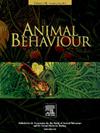社会注意力增加了成年类人猿对物体的记忆,而不是年轻类人猿
IF 2.3
2区 生物学
Q2 BEHAVIORAL SCIENCES
引用次数: 0
摘要
对灵长类物种的研究表明,社会模式(如同种动物)可以增强记忆(社会记忆效应,SME)。在这项预先登记的研究中,我们研究了类人猿从婴儿期到成年期(3个月至47岁)的SME个体发育及其认知机制,并探讨了其延迟后的持久性及其与唤醒注意测量(心率,HR)的相互作用。来自四种非人类类人猿的42个个体观看了社会性(手)和非社会性(机械爪)模型构建塔的视频,随后在一个新塔旁边展示了这个模型。两天后,我们又把熟悉的塔放在一个新的塔旁边。长时间注视新塔被解释为加工和识别熟悉的塔(新颖性反应,NR)。结果表明,在立即测试时,成人(仅)对手搭的塔的NR高于爪子搭的塔,但在延迟2天后则没有。我们认为,这种记忆效应可能是由于对社会模式的注意力增强所驱动的,因为成年人在社会条件下的HR相对于基线有所下降,而在非社会条件下的HR加速。然而,我们发现在年轻个体中NR和HR没有这种差异。本文章由计算机程序翻译,如有差异,请以英文原文为准。
Social attention increases object memory in adult but not younger great apes
Research across primate species showed that social models (e.g. conspecifics) enhance memory (social memory effect, SME). In this preregistered study, we examined the ontogeny of the SME and its cognitive mechanism in great apes from infancy to adulthood (3 months–47 years), and explored both its persistence after a delay and its interaction with attentional measures of arousal (heart rate, HR). Forty-two individuals from four nonhuman great ape species viewed videos of social (hand) and nonsocial (mechanical claw) models constructing a tower, which was subsequently presented next to a novel tower. After 2 days, we showed the familiarized tower again next to a novel tower. Looking longer at the novel tower was interpreted as processing and recognizing the familiar tower (novelty response, NR). Results showed that adults (only) demonstrated higher NR for the tower built by the hand compared to the tower built by the claw when tested immediately, but not after a 2-day delay. We propose that this memory effect may have been driven by enhanced attention towards the social model, as adults demonstrated decreased HR relative to baseline in the social condition and accelerated HR in the nonsocial condition. However, we found no such differentiation in NR and HR in the younger individuals.
求助全文
通过发布文献求助,成功后即可免费获取论文全文。
去求助
来源期刊

Animal Behaviour
生物-动物学
CiteScore
4.60
自引率
8.00%
发文量
236
审稿时长
10.2 weeks
期刊介绍:
Growing interest in behavioural biology and the international reputation of Animal Behaviour prompted an expansion to monthly publication in 1989. Animal Behaviour continues to be the journal of choice for biologists, ethologists, psychologists, physiologists, and veterinarians with an interest in the subject.
 求助内容:
求助内容: 应助结果提醒方式:
应助结果提醒方式:


